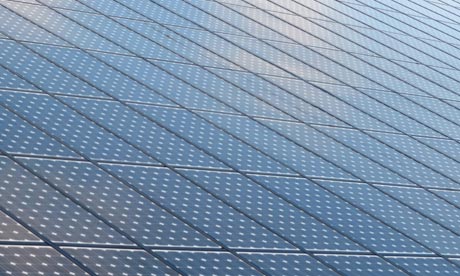Britain’s biggest array of solar panels has begun generating in Oxfordshire. The first large ground system to feed into the national grid will benefit from the tariff scheme paying a premium for supplying clean electricity.
Howbery business park’s companies specialise in engineering, environmental and water research and development and its 3,000-panel array generates up to 682 MWh a year, a quarter of its needs, and thereby save 350 tonnes of CO2 a year.
Derry Newman, chief executive of Solarcentury, the company that supplied the solar photovoltaic modules, said that the UK’s famously overcast weather did not make it an unsuitable place for solar power.

Howbery Business Park's 3,000 solar panels will generate a quarter of its needs. Photograph: Frederick Florin/AFP/Getty Images
“Solar works on daylight, not necessarily [direct] sunlight and it gets light every day in Britain,” he said. “Of course it generates more on a very bright day than a dull day. If you average over the year, the amount of cumulative daylight, energy per square metre, is very well known and is very predictable. Over the life of the system, the amount of energy produced is very predictable.”
Though the biggest in Britain, Howbery is dwarfed by those in Spain or Italy, up to 10 times bigger. Solarcentury, the panel maker, has similar projects due online next month, but these could be the UK’s last big solar farms for some time. In February, the government announced a review of feed-in tariffs for anyone generating more than 50k of power and cut the rates payable for large ground-mounted solar installations by more than 70%.
“This means that virtually all investors have withdrawn from financing such developments,” said Newman. “There were probably many hundreds lined up for development across the country. they’re pretty much all cancelled now because of the fast track review. This type of installation will be a relative rarity for a few years.”
But Newman is optimistic about the solar industry in the UK, however.
“They will come back because tariffs and subsidies for solar are a necessary device to create the industry right now but the rate of change of price of solar is on a strong downward trend,” he said.
“Within a few years, the amount of subsidy needed will go down significantly. When that happens, more of these can happen with less cost and become more attractive to investors.”
John Ormston, chief executive of HR Wallingford, which is based at the business park, said that Howbery Business Park was proud of its green credentials. “A centre of excellence with two highly sustainable, BREEAM Excellent rated office buildings and an operational Green Travel Plan, we are committed to leading the way in renewable energy and are proud to be showcasing the UK’s first solar business park.
Howbery Business Park will be one of only a few business parks in the UK where occupiers are able to secure a direct electrical supply from a solar array.”
 Follow
Follow